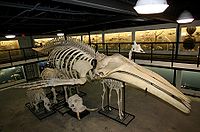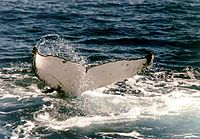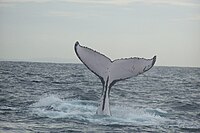Humpback whale
| Humpback whale[1] | |
|---|---|

| |

| |
| Size compared to an average human | |
| Scientific classification | |
| Kingdom: | |
| Phylum: | |
| Class: | |
| Subclass: | |
| Order: | |
| Suborder: | |
| Family: | |
| Genus: | Megaptera Gray, 1846
|
| Species: | M. novaeangliae
|
| Binomial name | |
| Megaptera novaeangliae Borowski, 1781
| |
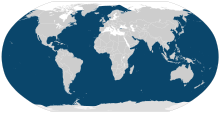
| |
| Humpback whale range | |
| Synonyms | |
| |
The humpback whale (Megaptera novaeangliae) is a species of baleen whale. One of the larger rorqual species, adults range in length from 12–16 metres (39–52 ft) and weigh approximately 36,000 kilograms (79,000 lb). The humpback has a distinctive body shape, with unusually long pectoral fins and a knobbly head. An acrobatic animal known for breaching and slapping the water with its tail and pectorals, it is popular with whale watchers off Australia, New Zealand, South America, Canada, and the United States.
Males produce a complex song lasting 10 to 20 minutes, which they repeat for hours at a time. Its purpose is not clear, though it may have a role in mating.
Found in oceans and seas around the world, humpback whales typically migrate up to 25,000 kilometres (16,000 mi) each year. Humpbacks feed only in summer, in polar waters, and migrate to tropical or subtropical waters to breed and give birth in the winter. During the winter, humpbacks fast and live off their fat reserves. Their diet consists mostly of krill and small fish. Humpbacks have a diverse repertoire of feeding methods, including the bubble net feeding technique.
Like other large whales, the humpback was and is a target for the whaling industry. Once hunted to the brink of extinction, its population fell by an estimated 90% before a moratorium was introduced in 1966. While stocks have since partially recovered, entanglement in fishing gear, collisions with ships, and noise pollution continue to impact the 80,000 humpbacks worldwide.
Taxonomy
| ||||||||||||||||||||||||||||||||||||||||||||||||
| A phylogenetic tree of animals related to the humpback whale |

Humpback whales are rorquals (family Balaenopteridae), a family that includes the blue whale, the fin whale, the Bryde's whale, the sei whale and the minke whale. The rorquals are believed to have diverged from the other families of the suborder Mysticeti as long ago as the middle Miocene.[3] However, it is not known when the members of these families diverged from each other.
Though clearly related to the giant whales of the genus Balaenoptera, the humpback has been the sole member of its genus since Gray's work in 1846. More recently, though, DNA sequencing analysis has indicated the humpback is more closely related to certain rorquals, particularly the fin whale (Balaenoptera physalus), and possibly to the gray whale (Eschrichtius robustus), than it is to rorquals such as the minke whales.[4][5] If further research confirms these relationships, it will be necessary to reclassify the rorquals.
The humpback whale was first identified as baleine de la Nouvelle Angleterre by Mathurin Jacques Brisson in his Regnum Animale of 1756. In 1781, Georg Heinrich Borowski described the species, converting Brisson's name to its Latin equivalent, Balaena novaeangliae. In 1804, Lacépède shifted the humpback from the Balaenidae family, renaming it Balaenoptera jubartes. In 1846, John Edward Gray created the genus Megaptera, classifying the humpback as Megaptera longipinna, but in 1932, Remington Kellogg reverted the species names to use Borowski's novaeangliae.[6] The common name is derived from the curving of their backs when diving. The generic name Megaptera from the Greek mega-/μεγα- "giant" and ptera/πτερα "wing",[7] refers to their large front flippers. The specific name means "New Englander" and was probably given by Brisson due the regular sightings of humpbacks off the coast of New England.[6]
Description
A humpback whale can easily be identified by its stocky body with an obvious hump and black dorsal coloring. The head and lower jaw are covered with knobs called tubercles, which are hair follicles, and are characteristic of the species. The fluked tail, which it lifts above the surface in some dive sequences, has wavy trailing edges.[8] The four global populations, all under study, are: North Pacific, Atlantic, and Southern Ocean humpbacks, which have distinct populations which complete a migratory round-trip each year, and the Indian Ocean population, which does not migrate, prevented by that ocean's northern coastline.
The long black and white tail fin, which can be up to a third of body length, and the pectoral fins have unique patterns, which make individual whales identifiable.[9][10] Several hypotheses attempt to explain the humpback's pectoral fins, which are proportionally the longest fins of any cetacean. The two most enduring mention the higher maneuverability afforded by long fins, and the usefulness of the increased surface area for temperature control when migrating between warm and cold climates.
Humpbacks have 270 to 400 darkly coloured baleen plates on each side of their mouths.[11] The plates measure from a mere 18 inches (46 cm) in the front to approximately 3 feet (0.91 m) long in the back, behind the hinge. Ventral grooves run from the lower jaw to the umbilicus about halfway along the underside of the whale. These grooves are less numerous (usually 14–22) than in other rorquals but are fairly wide.[11]
The stubby dorsal fin is visible soon after the blow when the whale surfaces, but disappears by the time the flukes emerge. Humpbacks have a 3 metres (9.8 ft), heart-shaped to bushy blow, or exhalation of water through the blowholes. Because humpback whales breathe voluntarily, the whales possibly shut off only half of their brains when sleeping.[12] Early whalers also noted blows from humpback adults to be 10–20 feet (3.0–6.1 m) high.
Newborn calves are roughly the length of their mother's head. At birth, calves measure 20 feet (6.1 m) at 2 short tons (1.8 t) The mother, by comparison, is about 50 feet (15 m). They nurse for approximately six months, then mix nursing and independent feeding for possibly six months more. Humpback milk is 50% fat and pink in color.
Females reach sexual maturity at the age of five, achieving full adult size a little later. Males reach sexual maturity at approximately seven years of age. Humpback whale lifespans range from 45–100 years.[13] Fully grown, the males average 13–14 m (43–46 ft). Females are slightly larger at 15–16 m (49–52 ft); the largest recorded specimen was 19 metres (62 ft) long and had pectoral fins measuring 6 metres (20 ft) each.[14] Body mass typically is in the range of 25–30 metric tons (28–33 short tons), with large specimens weighing over 40 metric tons (44 short tons).[15] The female has a hemispherical lobe about 15 centimetres (5.9 in) in diameter in its genital region. This visually distinguishes males and females.[11] The male's penis usually remains hidden in the genital slit.
Identifying individuals
The varying patterns on the tail flukes are sufficient to identify individuals. A study using data from 1973 to 1998 on whales in the North Atlantic gave researchers detailed information on gestation times, growth rates, and calving periods, as well as allowing more accurate population predictions by simulating the mark-release-recapture technique (Katona and Beard 1982). A photographic catalogue of all known North Atlantic whales was developed over this period and is currently maintained by College of the Atlantic.[16] Similar photographic identification projects have begun in the North Pacific by Structure of Populations, Levels of Abundance and Status of Humpbacks, and around the world.
-
Mother and calf in Boston Harbor
-
A humpback whale tail displaying wavy rear edges
-
A tail from a different individual—the tail of each humpback whale is visibly unique.
Life history
Social structure
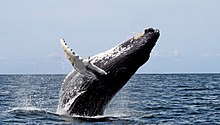

The humpback social structure is loose-knit. Typically, individuals live alone or in small, transient groups that disband after a few hours. These whales are not excessively social in most cases. Groups may stay together a little longer in summer to forage and feed cooperatively. Longer-term relationships between pairs or small groups, lasting months or even years, have rarely been observed. Some females possibly retain bonds created via cooperative feeding for a lifetime. The humpback's range overlaps considerably with other whale and dolphin species—for instance, the minke whale. However, humpbacks rarely interact socially with them, though one individual was observed playing with a bottlenose dolphin in Hawaiian waters.[17]
Courtship and reproduction
Courtship rituals take place during the winter months, following migration toward the equator from summer feeding grounds closer to the poles. Competition is usually fierce, and unrelated males, dubbed escorts by researcher Louis Herman, frequently trail females, as well as mother-calf dyads. Male gather into "competitive groups" and fight for females.[18] Group size ebbs and flows as unsuccessful males retreat and others arrive to try their luck. Behaviors include breaching, spyhopping, lob-tailing, tail-slapping, fin-slapping, peduncle throws, charging and parrying. Whale songs are assumed to have an important role in mate selection; however, they may also be used between males to establish dominance.[19]
Females typically breed every two or three years. The gestation period is 11.5 months, yet some individuals have been known to breed in two consecutive years. The peak months for birth are January, February, July, and August, with usually a one- to two–year period between humpback births. They can live up to 48 years. Recent research on humpback mitochondrial DNA reveals groups living in proximity to each other may represent distinct breeding pools.[20]
Song

Both male and female humpback whales vocalize, but only males produce the long, loud, complex "songs" for which the species is famous. Each song consists of several sounds in a low register, varying in amplitude and frequency, and typically lasting from 10 to 20 minutes.[21] Humpbacks may sing continuously for more than 24 hours. Cetaceans have no vocal cords, so whales generate their songs by forcing air through their massive nasal cavities.
Whales within a large area sing the same song. All North Atlantic humpbacks sing the same song, and those of the North Pacific sing a different song. Each population's song changes slowly over a period of years without repeating.[21]
Scientists are unsure of the purpose of whale songs. Only males sing, suggesting one purpose is to attract females. However, many of the whales observed to approach a singer are other males, often resulting in conflict. Singing may, therefore, be a challenge to other males.[22] Some scientists have hypothesized the song may serve an echolocative function.[23] During the feeding season, humpbacks make altogether different vocalizations for herding fish into their bubble nets.[24]
Humpback whales have also been found to make a range of other social sounds to communicate, such as "grunts", "groans", "thwops", "snorts" and "barks".[25]
Ecology

Feeding and predation
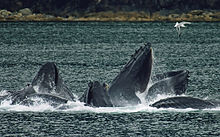
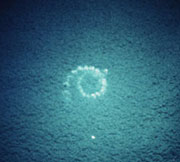

Humpbacks feed primarily in summer and live off fat reserves during winter.[26] They feed only rarely and opportunistically in their wintering waters. The humpback is an energetic hunter, taking krill and small schooling fish such as Atlantic herring, Atlantic salmon, capelin, and American sand lance, as well as Atlantic mackerel, pollock, and haddock in the North Atlantic.[27][28][29] Krill and copepods have been recorded as prey species in Australian and Antarctic waters.[30] Humpbacks hunt by direct attack or by stunning prey by hitting the water with pectoral fins or flukes.

The humpback has the most diverse feeding repertoire of all baleen whales.[31] Its most inventive technique is known as bubble net feeding; a group of whales swims in a shrinking circle blowing bubbles below a school of prey. The shrinking ring of bubbles encircles the school and confines it in an ever-smaller cylinder. This ring can begin at up to 30 metres (98 ft) in diameter and involve the cooperation of a dozen animals. Using a crittercam attached to a whale's back, researchers found that some whales blow the bubbles, some dive deeper to drive fish toward the surface, and others herd prey into the net by vocalizing.[32] The whales then suddenly swim upward through the "net", mouths agape, swallowing thousands of fish in one gulp. Plated grooves in the whale's mouth allow the creature to easily drain all the water initially taken in.
A study published in the April 26, 2013 issue of Science documents a new form of bubble-net feeding called lobtail feeding among a population of whales in the Northern Atlantic Ocean. This technique involves the whale slapping the surface of the ocean with his tail between one and four times before creating the bubble net.[33] Using network-based diffusion analysis, the authors argue that the whales in this group learned the behavior socially from other whales in the group over a period of 27 years in response to a change in the primary form of prey.[34]
Given scarring records, killer whales are thought to prey upon juvenile humpbacks, though this has never been witnessed. The result of these attacks is generally nothing more serious than some scarring of the skin, but young calves likely are sometimes killed.[35]
Range and habitat
Humpbacks inhabit all major oceans, in a wide band running from the Antarctic ice edge to 77° N latitude, though not in the eastern Mediterranean or the Baltic Sea. They are migratory, spending summers in cooler, high-latitude waters and mating and calving in tropical and subtropical waters.[21] An exception to this rule is a population in the Arabian Sea, which remains in these tropical waters year-round.[21] Annual migrations of up to 25,000 kilometres (16,000 mi) are typical, making it one of the mammals' best-traveled species.
A large population spreads across the Hawaiian Islands every winter, ranging from the island of Hawaii in the south to Kure Atoll in the north.[36] A 2007 study identified seven individuals wintering off the Pacific coast of Costa Rica as having traveled from the Antarctic—around 8,300 kilometres (5,200 mi). Identified by their unique tail patterns, these animals made the longest documented mammalian migration.[37] In Australia, two main migratory populations have been identified, off the west and east coasts, respectively. These two populations are distinct, with only a few females in each generation crossing between the two groups.[38]
Whaling
Humpback whales were hunted as early as the 18th century, but distinguished by whalers as early as the first decades of the 17th century. By the 19th century, many nations (the United States in particular), were hunting the animal heavily in the Atlantic Ocean, and to a lesser extent in the Indian and Pacific Oceans. The late-19th-century introduction of the explosive harpoon, though, allowed whalers to accelerate their take. This, along with hunting in the Antarctic Ocean beginning in 1904, sharply reduced whale populations. During the 20th century, over 200,000 humpbacks were estimated to have been taken, reducing the global population by over 90%, with North Atlantic populations estimated to have dropped to as low as 700 individuals.[39] In 1946, the International Whaling Commission was founded to oversee the whaling industry. They imposed rules and regulations for hunting whales and set open and closed hunting seasons. To prevent extinction, the International Whaling Commission banned commercial humpback whaling in 1966. By then, the population had been reduced to around 5,000.[40] That ban is still in force.
Prior to commercial whaling, populations could have reached 125,000. North Pacific kills alone are estimated at 28,000.[8] The full toll is much higher. It is now known that the Soviet Union was deliberately under-recording its catches; the Soviet catch was reported at 2,820, whereas the true number is now believed to be over 48,000.[41]
As of 2004, hunting of humpback whales was restricted to a few animals each year off the Caribbean island Bequia in the nation of St. Vincent and the Grenadines.[31] The take is not believed to threaten the local population. Japan had planned to kill 50 humpbacks in the 2007/08 season under its JARPA II research program, starting in November 2007. The announcement sparked global protests.[42] After a visit to Tokyo by the chairman of the IWC, asking the Japanese for their co-operation in sorting out the differences between pro- and antiwhaling nations on the Commission, the Japanese whaling fleet agreed no humpback whales would be caught for the two years it would take for the IWC to reach a formal agreement.[43]
In 2010, the International Whaling Commission authorized Greenland's native population to hunt a few humpback whales for the next three years.[44]
Conservation


The worldwide population is at least 80,000 humpback whales, with 18,000–20,000 in the North Pacific,[45] about 12,000 in the North Atlantic,[46] and over 50,000 in the Southern Hemisphere,[47] down from a prewhaling population of 125,000.[8]
This species is considered "least concern" from a conservation standpoint, as of 2008. This is an improvement from vulnerable in 1996 and endangered as recently as 1988. Most monitored stocks of humpback whales have rebounded well since the end of commercial whaling,[2][48] such as the North Atlantic, where stocks are now believed to be approaching levels similar to those before hunting began. However, the species is considered endangered in some countries, including the United States.[49][50] The United States initiated a status review of the species on August 12, 2009, and is seeking public comment on potential changes to the species listing under the Endangered Species Act.[51] Areas where population data are limited and the species may be at higher risk include the Arabian Sea, the western North Pacific Ocean, the west coast of Africa and parts of Oceania.[2]
Today, individuals are vulnerable to collisions with ships, entanglement in fishing gear, and noise pollution.[2] Like other cetaceans, humpbacks can be injured by excessive noise. In the 19th century, two humpback whales were found dead near sites of repeated oceanic sub-bottom blasting, with traumatic injuries and fractures in the ears.[52]
Once hunted to the brink of extinction, the humpback has made a dramatic comeback in the North Pacific. A 2008 study estimated the humpback population, which hit a low of 1,500 whales before hunting was banned worldwide, has made a comeback to a population of between 18,000 and 20,000.[53] Saxitoxin, a paralytic shellfish poisoning from contaminated mackerel has been implicated in humpback whale deaths.[54]
The United Kingdom, among other countries, designated the humpback as a priority species under the national Biodiversity Action Plan. The sanctuary provided by US National Parks, such as Glacier Bay National Park and Preserve and Cape Hatteras National Seashore, among others, have also become major factors in sustaining populations.[55]
Although much was learned about humpbacks from whaling, migratory patterns and social interactions were not well understood until two studies by R. Chittleborough and W. H. Dawbin in the 1960s.[56] Roger Payne and Scott McVay made further studies of the species in 1971.[57] Their analysis of whale songs led to worldwide media interest and convinced the public that whales were highly intelligent, aiding the antiwhaling advocates.
In August 2008, the IUCN changed humpback's status from Vulnerable to Least Concern, although two subpopulations remain endangered.[58] The United States is considering listing separate humpback populations, so smaller groups, such as North Pacific humpbacks, which are estimated to number 18,000-20,000 animals, might be delisted. This is made difficult by humpback's extraordinary migrations, which can extend the 5,157 miles (8,299 km) from Antarctica to Costa Rica.[20]
Whale-watching

Humpback whales are generally curious about objects in their environments. Some individuals, referred to as "friendlies", approach whale-watching boats closely, often staying under or near the boat for many minutes. Because humpbacks are often easily approachable, curious, easily identifiable as individuals, and display many behaviors, they have become the mainstay of whale-watching tourism in many locations around the world. Hawaii has used the concept of "ecotourism" to use the species without killing them. This whale-watching business brings in a revenue of $20 million per year for the state's economy.[59]
| North Atlantic | North Pacific | Southern Hemisphere | |
|---|---|---|---|
| Summer | New England, Nova Scotia and Newfoundland, the northern St. Lawrence River, the Snaefellsnes peninsula in the west of Iceland | California, Alaska, Oregon, Washington, British Columbia | Antarctica, Bahía Solano and Nuquí in Colombia |
| Winter | Samaná Province of the Dominican Republic, the Bay of Biscay France, | Hawaii, Baja, the Bahía de Banderas off Puerto Vallarta | Sydney, Byron Bay north of Sydney, Hervey Bay north of Brisbane, North and East of Cape Town, New Zealand, the Tongan islands, |
Famous humpbacks
The Tay whale

In December 1883, a male humpback swam up the Firth of Tay in Scotland, past what was then the whaling port of Dundee. The whale was exhibited to the public by a local entrepreneur, John Woods, both locally and then as a touring exhibition which travelled to Edinburgh and London. The whale was dissected by professor John Struthers, who wrote seven papers on its anatomy, and then in 1889, a monograph on the humpback.[60][61][62][63]
Migaloo
A presumably albino humpback whale that travels up and down the east coast of Australia became famous in the local media on account of its extremely rare, all-white appearance. Migaloo is the only known all-white humpback whale.[64] First sighted in 1991, and believed to be three to five years old at that time, Migaloo was named for an indigenous Australian word for "white fella". Migaloo was shown to be male in 2004 by analysis of sloughed skin samples. Because of the intense interest, environmentalists feared he was becoming distressed by the number of boats following him each day. In response, the Queensland and New South Wales governments introduce legislation each year to create a 500-m (1600-ft) exclusion zone around the whale. Recent closeup pictures have shown Migaloo to have skin cancer and/or skin cysts as a result of his lack of protection from the sun.[65]
In 2006, a white calf was spotted with a normal humpback mother in Byron Bay, New South Wales.[66]
Humphrey
Humphrey the Whale was twice rescued by The Marine Mammal Center and other concerned groups in California.[67][68] In 1985, Humphrey swam into San Francisco Bay and then up the Sacramento River towards Rio Vista.[69] Five years later, Humphrey returned and became stuck on a mudflat in San Francisco Bay immediately north of Sierra Point below the view of onlookers from the upper floors of the Dakin Building. He was pulled off the mudflat with a large cargo net and the help of the Coast Guard. Both times, he was successfully guided back to the Pacific Ocean using a "sound net" in which people in a flotilla of boats made unpleasant noises behind the whale by banging on steel pipes, a Japanese fishing technique known as oikami. At the same time, the attractive sounds of humpback whales preparing to feed were broadcast from a boat headed towards the open ocean.[70] After leaving San Francisco Bay in 1990, Humphrey was seen only once, at the Farallon Islands in 1991.
Media
See also
Footnotes
- ^ Mead, J. G.; Brownell, R. L. Jr. (2005). "Order Cetacea". In Wilson, D. E.; Reeder, D. M. (eds.). Mammal Species of the World: A Taxonomic and Geographic Reference (3rd ed.). Johns Hopkins University Press. pp. 723–743. ISBN 978-0-8018-8221-0. OCLC 62265494.
- ^ a b c d Template:IUCN2012.2
- ^ Gingerich P (2004). "Whale Evolution". McGraw-Hill Yearbook of Science & Technology (PDF). The McGraw Hill Companies.
- ^ Arnason, U., Gullberg A. & Widegren, B. (September 1, 1993). "Cetacean mitochondrial DNA control region: sequences of all extant baleen whales and two sperm whale species". Molecular Biology and lution. 10 (5): 960–970. PMID 8412655. Retrieved 2009-01-25.
{{cite journal}}: CS1 maint: multiple names: authors list (link) - ^ Sasaki, T.; et al. (March 4, 2011). "Mitochondrial Phylogenetics and Evolution of Mysticete Whales". Systematic Biology. 54 (1): 77–90. doi:10.1080/10635150590905939. PMID 15805012. Retrieved 2011-06-06.
{{cite journal}}: Explicit use of et al. in:|author=(help) - ^ a b Martin S (2011). The Whales' Journey. Allen & Unwin Pty., Limited. p. 251. ISBN 1-86508-232-5.
- ^ Liddell & Scott (2011). Greek-English Lexicon, Abridged Edition. Oxford University Press, Oxford, UK. ISBN 0-19-910207-4.
- ^ a b c Recovery Plan for the Humpback Whale (Megapten Novaeangliae) (PDF). National Oceanic and Atmospheric Administration. 1991. Retrieved 2011-06-30.
- ^ Katona S.K. and Whitehead, H.P. (1981). "Identifying humpback whales using their mural markings". Polar Record (20): 439–444.
- ^ Kaufman G., Smultea M.A. and Forestell P. (1987). "Use of lateral body pigmentation patterns for photo ID of east Australian (Area V) humpback whales". Cetus. 7 (1): 5–13.
- ^ a b c Chapham, Phillip J.; Mead, James G. (1999). "Megaptera novaeangliae" (PDF). Mammalian Species. 604: 1–9.
{{cite journal}}: CS1 maint: multiple names: authors list (link) - ^ O. I. Lyamin, L. M. Mukhametov, J. M. Siegel, P. R. Manger, and O. V. Shpak (2001). "Resting behavior in a rehabilitating gray whale calf" (pdf). Aquatic Mammals. 27.3: 256–266.
{{cite journal}}: CS1 maint: multiple names: authors list (link) - ^ Dawes 2008, p.291
- ^ Clapham 2002, p.589–592
- ^ Burnie D and Wilson DE (Eds.), Animal: The Definitive Visual Guide to the World's Wildlife. DK Adult (2005), ISBN 0789477645
- ^ Williamson JM (2005). "Whalenet Data Search". Wheelock College. Retrieved 2007-04-03.
- ^ Deakos, Mark H.; et al. (2010). "Two Unusual Interactions Between a Bottlenose Dolphin (Tursiops truncatus) and a Humpback Whale (Megaptera novaeangliae) in Hawaiian Waters" (PDF). Aquatic Mammals. 36 (2): 121–28. doi:10.1578/AM.36.2.2010.121.
{{cite journal}}: Explicit use of et al. in:|author=(help) - ^ Clapham, Phillip J. (2008). "Humpback Whale Megaptera novaeangliae". In Perrin, William F.; Würsig, Bernd; Thewissen, J.G.M. (eds.). Encyclopedia of Marine Mammals (2nd ed.). pp. 582–84. ISBN 012373553X.
- ^ Darling, J.; et al. (2006). "Humpback whale songs: Do they organize males during the breeding season?" (PDF). Behavior. 143: 1051–1101.
{{cite journal}}: Explicit use of et al. in:|author=(help) - ^ a b
Hotz, Robert Lee (11/06/09). "Whale Watch: Endangered Designation In Danger". The Wall Street Journal. Retrieved 11/08/09.
{{cite news}}: Check date values in:|accessdate=and|date=(help) - ^ a b c d "American Cetacean Society Fact Sheet". American Cetacean Society. Retrieved 2007-04-17.
- ^ "Humpback Whales. Song of the Sea". Public Broadcasting Station. Retrieved 2007-04-22.
- ^ Mercado E III & Frazer LN (2001). "Humpback Whale Song or Humpback Whale Sonar? A Reply to Au et al" (PDF). IEEE Journal of Oceanic Engineering. 26 (3): 406–415. doi:10.1109/48.946514. Retrieved 3 April 2007.
{{cite journal}}: Unknown parameter|month=ignored (help) - ^ Mercado E III, Herman LM & Pack AA (2003). "Stereotypical sound patterns in humpback whale songs: Usage and function" (PDF). Aquatic Mammals. 29 (1): 37–52. doi:10.1578/016754203101024068. Retrieved 3 April 2007.
- ^ Cecilia Burke, ''A whale's varied vocabulary', Australian Geographic, AG Online. Retrieved August 7, 2010.
- ^ Encyclopedia of Life & Peter Saundry. 2011. Humpback whale. eds. C.Michael Hogan and C.J.Cleveland, Encyclopedia of Earth, National Council for Science and Environment, Washington, DC
- ^ Overholtz W.J. and Nicholas J.R. (1979). "Apparent feeding by the fin whale, Balaenoptera physalus, and humpback whale, Megaptera novaeangliae, on the American sand lance, Ammodytes americanus, in the Northwest Atlantic". Fish. Bull. (77): 285–287.
- ^ Whitehead H. (1987). "Updated status of the humpback whale, Megaptera novaeangliae, in Canada". Canadian Field-Naturalist. 101 (2): 284–294.
- ^ Meyer T.L., Cooper R.A. and Langton R.W. (1979). "Relative abundance, behavior and food habits of the American sand lance (Ammodytes americanus) from the Gulf of Maine". Fish. Bull. 77 (1): 243–253.
- ^ Nemoto T. (1959). "Food of baleen whales with reference to whale movements". Scientific Reports of the Whales Research Institute (14): 149–290.
- ^ a b Prepared by the Humpback Whale Recovery Team for the National Marine Fisheries Service, Silver Spring, Maryland (1991). Recovery Plan for the Humpback Whale (Megaptera novaeangliae). National Marine Fisheries Service. p. 105.
{{cite book}}: CS1 maint: multiple names: authors list (link) - ^ Acklin, Deb (2005-08-05). "Crittercam Reveals Secrets of the Marine World". National Geographic News. Retrieved 2007-11-01.
- ^ Allen, Jenny (26 April 2013). "Network-Based Diffusion Analysis Reveals Cultural Transmission of Lobtail Feeding in Humpback Whales". Science. 340 (6131): 485–188. doi:10.1126/science.1231976.
{{cite journal}}:|access-date=requires|url=(help); Unknown parameter|coauthors=ignored (|author=suggested) (help) - ^ Lee, Jane J. (April 25, 2013). "Do Whales Have Culture? Humpbacks Pass on Behavior". National Geographic. Retrieved 30 April 2013.
- ^ Clapham, P.J. (1996). "The social and reproductive biology of humpback whales: an ecological perspective" (PDF). Mammal New studies (Ferrari, Mizroch, et al.) show first year calf mortality is 18-20%. Mortality beyond the first year is still being studied. Review. 26 (26): 27–49. doi:10.1111/j.1365-2907.1996.tb00145.x. Retrieved 2007-04-26.
- ^ Lammers, Marc O.; Fisher-Pool, Pollyanna I.; Au, Whitlow W. L.; Meyer, Carl G.; Wong, Kevin B.; Brainard, Russell E. (February 1, 2011). "Humpback whale Megaptera novaeangliae song reveals wintering activity in the Northwestern Hawaiian Islands". Marine Ecology Progress Series. 423: 261–268. doi:10.3354/meps08959.
{{cite journal}}:|access-date=requires|url=(help) - ^ Rasmussen K, Palacios DM, Calambokidis J, Saborío MT, Dalla Rosa L, Secchi ER, Steiger GH, Allen JM, & Stone GS (2007). "Southern Hemisphere humpback whales wintering off Central America: insights from water temperature into the longest mammalian migration". Biology Letters. 3 (10.1098/rsbl.2007.0067): 302. doi:10.1098/rsbl.2007.0067. ISSN 1744-957X.
{{cite journal}}: CS1 maint: multiple names: authors list (link) - ^ "Megaptera novaeangliae in Species Profile and Threats Database". Australian Government: Department of the Environment and Water Resources. 2007. Retrieved 2007-04-17.
- ^ Breiwick JM, Mitchell E, Reeves RR (1983) Simulated population trajectories for northwest Atlantic humpback whales 1865–1980. Fifth biennial Conference on Biology of Marine Mammals, Boston Abstract. p14
- ^ Baker, C. S.; Perry, A; Bannister, JL; Weinrich, MT; Abernethy, RB; Calambokidis, J; Lien, J; Lambertsen, RH; Ramírez, JU (1993). "Abundant mitochondrial DNA variation and world-wide population structure in humpback whales" (PDF). Proceedings of the National Academy of Sciences. 90 (17): 8239–8243. doi:10.1073/pnas.90.17.8239. PMC 47324. PMID 8367488. Retrieved 2009-01-12.
Before protection by international agreement in 1966, the world-wide population of humpback whales had been reduced by hunting to <5000, with some regional subpopulations reduced to <200...
{{cite journal}}: Cite has empty unknown parameter:|coauthors=(help); Unknown parameter|month=ignored (help) - ^ Prof. Alexey V. Yablokov (1997). "On the Soviet Whaling Falsification, 1947–1972". Whales Alive!. 6 (4). Cetacean Society International.
- ^ scoop.co.nz: Leave Humpback Whales Alone Message To Japan 16 May 2007
- ^ Hogg, Chris (2007-12-21). "Japan changes track on whaling". BBC News. Retrieved 2010-01-05.
- ^ "WORLD BRIEFING". The New York Times. 26 June 2010. p. 7.
{{cite news}}:|first=missing|last=(help); Text "EUROPE; Greenland: Humpback Whales Are Deemed Eligible For Hunting" ignored (help) - ^ "Humpbacks Make a Splash in the N. Pacific". Wildwhales.org. 2008-05-23. Retrieved 2011-06-07.
- ^ "NOAA SARS Humpback whales, North Atlantic" (PDF). Nmfs.noaa.gov. 2008-04-01. Retrieved 2011-06-07.
- ^ "Humpback whale abundance south of 60°S from three complete circumpolar sets of surveys" (PDF). Retrieved 2011-06-07.
- ^ "Study: Humpback whale population is rising". 2008-05-23. Retrieved 2008-05-23.
- ^ "US National Marine Fisheries Service humpback whale web page". Nmfs.noaa.gov. Retrieved 2010-12-21.
- ^ "Humpback Whale (Megaptera novaeangliae)". Division of Wildlife Conservation, Alaska Department of Fish and Game. 2006. Retrieved 2008-02-10.
- ^ "Initiation of a Status Review for the Humpback Whale". Edocket.access.gpo.gov. Retrieved 2010-12-21.
- ^ Ketten, D. R.; Lien, J.; Todd, J. (1993). "Blast injury in humpback whale ears: Evidence and implications". Journal of the Acoustical Society of America. 94 (3): 1849–50. doi:10.1121/1.407688.
{{cite journal}}: CS1 maint: multiple names: authors list (link) - ^ "Humpback Whales Make Dramatic Comeback". Fox News. Associated Press. May 25, 2008. Retrieved 2009-08-07.
- ^ Dierauf L & Gulland F (2001). Marine Mammal Medicine. CRC Press. ISBN 0-8493-0839-9.
- ^ "Humpback Whale (Megaptera novaeangliae)". National Parks Conservation Association. Retrieved 2007-04-19.
- ^ Chittleborough, RG. (1965). "Dynamics of two populations of the humpback whale". Australian Journal of Marine and Freshwater Research. 16: 33–128. doi:10.1071/MF9650033.
- ^ Payne, RS; McVay, S. (1971). "Songs of humpback whales". Science. 173 (3997): 585–597. doi:10.1126/science.173.3997.585. PMID 17833100.
- ^ "Humpback whale on road to recovery, reveals IUCN Red List". IUCN. 2008-08-12. Retrieved 2008-08-12.
- ^ "Whale Watching in Hawai`i". Office of National Marine Sanctuaries. Retrieved 6 August 2012.
- ^ "Professor Struthers and the Tay Whale". Retrieved 2008-06-19.
- ^ Attention: This template ({{cite pmid}}) is deprecated. To cite the publication identified by PMID 8807706, please use {{cite journal}} with
|pmid=8807706instead. - ^ Pennington, C. The modernisation of medical teaching at Aberdeen in the nineteenth century. Aberdeen University Press, 1994.
- ^ John Struthers. Memoir on the Anatomy of the Humpback Whale, Megaptera Longimana, 1889.
- ^ "Exclusion zone for special whale". BBC News. 2009-06-30. Retrieved 2009-06-30.
- ^ "Migaloo, the White Humpback Whale". Pacific Whale Foundation. 2004. Retrieved 2007-04-03.
- ^ New white whale spotted
- ^ Tokuda W (1992) Humphrey the lost whale, Heian Intl Publishing Company. ISBN 0-89346-346-9
- ^ Callenbach E & Leefeldt C Humphrey the Wayward Whale, ISBN 0-930588-23-1
- ^ Jane Kay, San Francisco Examiner Monday, 9 October 1995
- ^ Toni Knapp, The Six Bridges of Humphrey the Whale. Illustrated by Craig Brown. Roberts Rinehart, 1993 (1989)
References
Books
- Clapham, Phil. (1996). Humpback Whales. ISBN 0-948661-87-9
- Clapham, Phil (2002). "Humpback Whale". Encyclopedia of Marine Mammals. San Diego: Academic Press. ISBN 0-12-551340-2.
- Dawbin, W. H. The seasonal migratory cycle of humpback whales. In K.S. Norris (ed), Whales, Dolphins and Porpoises. University of California Press.
- Dawes, John (2008). Exploring the World of Aquatic Life. Infobase Publishing. ISBN 978-1-60413-255-7. Retrieved 2011-01-08.
{{cite book}}: Unknown parameter|coauthors=ignored (|author=suggested) (help) - Evans, Peter G. H., and Juan Antonio. Raga. Marine Mammals: Biology and Conservation. New York: Kluwer Academic/Plenum, 2001. Print.
- Reeves, Stewart, Clapham and Powell. (2002) National Audubon Society Guide to Marine Mammals of the World. Knopf. ISBN 0-375-41141-0
- Struthers, John (1889). Memoir on the Anatomy of the Humpback Whale, Megaptera Longimana. Edinburgh: Maclachlan.
Journal articles
- Best, P. B. (1993). "Increase rates in severely depleted stocks of baleen whales". ICES Journal of Marine Science. 50 (2): 169–186. doi:10.1006/jmsc.1993.1018.
- Smith, T.D.; Allen, J.; Clapham, P.J.; Hammond, P.S.; Katona, S.; Larsen, F.; Lien, J.; Mattila, D.; Palsboll, P.J.; et al. (1999). "An ocean-basin-wide mark-recapture study of the North Atlantic humpback whale". Marine Mammal Science. 15: 1–32. doi:10.1111/j.1748-7692.1999.tb00779.x.
{{cite journal}}: Explicit use of et al. in:|first9=(help) - Franklin, T.; Franklin, W.; Brooks, L.; Harrison, P.; Baverstock, P.; Clapham, P. (2011). "Seasonal changes in pod characteristics of eastern Australian humpback whales (Megaptera novaeangliae), Hervey Bay 1992–2005". Marine Mammal Science. 27 (3): E134–E152. doi:10.1111/j.1748-7692.2010.00430.x.
External links
- General
- US National Marine Fisheries Service Humpback Whale web page
- ARKive - images and movies of the humpback whale (Megaptera novaeangliae).
- Photos and information about humpback whales and other cetaceans in Mayumba National Park
- Humpbacks of Hervey Bay, Queensland, Australia
- The Dolphin Institute Whale Resource Guide and scientific publications
- Humpback Whale Gallery (Silverbanks)
- Template:Fr iconHumpback whale videos
- Book about the two humpback whales lost in the Sacramento River in May 2007 -
- The Humpback Whales of Hervey Bay
- Epic humpback whale battle filmed
- Humpback whale songs
- The Whalesong Project
- Article from PHYSORG.com on the complex syntax of whalesong phrases
- Analysis of the form and function of the humpback whale song from the University at Buffalo
- Songlines - Songs of the Eastern Australian Humpback whales
- Conservation
- Recovery plan in Australia: 2005–2010
- Humpback Whales in the Sacramento River by the NOAA
- The Oceania Project, Humpback Whale Research, Hervey Bay
Template:Link GA Template:Link GA Template:Link GA Template:Link FA Template:Link FA Template:Link FA Template:Link FA Template:Link FA Template:Link FA


